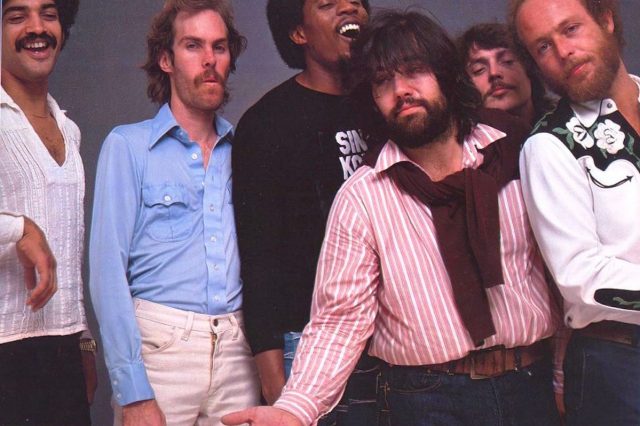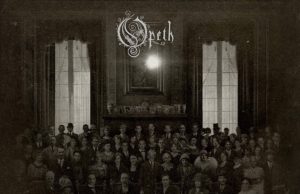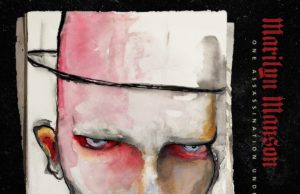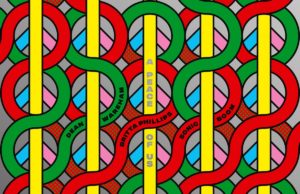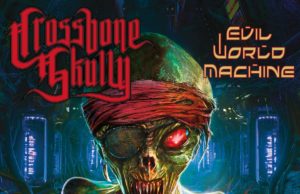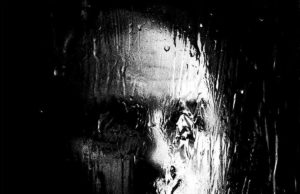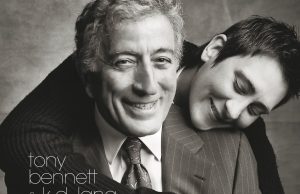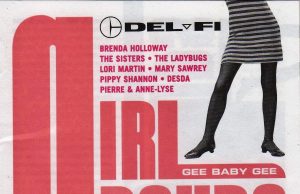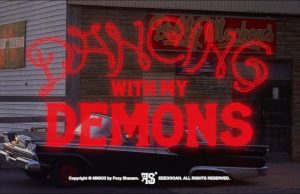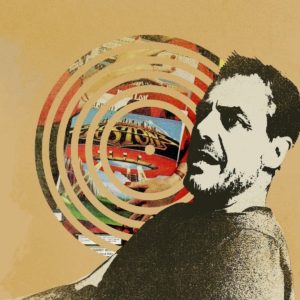 I was drawn to Little Feat before I ever heard a note of their music.
I was drawn to Little Feat before I ever heard a note of their music.
When I was 15, I bought a copy of the Harmony Illustrated Encyclopedia of Rock. It was my bible. I read it constantly, and never left home without it. In those days before the Internet, I took it to the washroom on every visit and studied the interconnected histories of rock musicians until my legs fell asleep.
In the book, which I still own, was an image of Little Feat’s 1974 album Feats Don’t Fail Me Now. Its distinctive cover art by Neon Park fascinated me — colourful, confounding and engrossing. It showed George Washington behind the wheel of a 1946 Lincoln Continental with eyes for headlights and a HOY HOY licence plate. Marilyn Monroe is pressed right up against him, and they’re headed up a winding, mountain road during a forked-lightning thunderstorm. With a cover like that, the album had to be great. If I remember correctly, I bought it and Dixie Chicken (1973) at the same time — both from the delete bin of a local record store in Pembroke, Ont. I prefer Feats to Dixie Chicken, but both are incredible, of course. There are two songs on Feats which immediately spellbound me: Rock & Roll Doctor and The Fan.
Coincidentally, another album sleeve which jumped off the pages of the book was Weasels Ripped My Flesh by The Mothers Of Invention. I later discovered both sleeves were by the same artist. Not only that, but Little Feat co-founder Lowell George — a former member of The Mothers — is on both albums. I bought Weasels Ripped My Flesh on CD, and promptly had a T-shirt made of it, by taking it to a local camera shop and getting the CD booklet cover scanned. Oh, the technology.
I still love Little Feat. There are a myriad of reasons why. First, they’re not overplayed. You never hear them in ads, soundtracks or on the radio. It gives them a caché you won’t find with most of their peak-era contemporaries like The Doobie Brothers, Eagles or Lyrnyrd Skynyrd. But mostly, it’s because the band had such a weird and varied dynamic. George formed the band with keyboardist Bill Payne, then added drummer Ritchie Hayward and fellow ex-Mothers bassist Roy Estrada. Hayward is probably my favourite drummer of all time, and when we were in high school, Jordon Zadorozny (Blinker The Star) and I had a band named after Roy Estrada. In fact, two of the tracks on the debut Blinker The Star album — My Kinda Fun and Hunting At The Zoo — are actually recordings by Estrada.
The first two Little Feat albums (Little Feat and Sailin’ Shoes) were critically acclaimed, but not commercial successes. So the band broke up for the first of several times. When they got back together several months later, Estrada was replaced with Kenny Gradney and the band added guitarist Paul Barrere and percussionist Sam Clayton. This became their classic lineup; the one which produced Dixie Chicken and Feats Don’t Fail Me Now. However, even though the albums are a year apart, the band broke up for a second time between them due to continued poor sales.
Their sound changed again for their next release, The Last Record Album (1975), due to Payne and Barrere’s interest in jazz fusion. George did not share this interest and contributed far less than before as a songwriter. They managed to put out the double live album Waiting For Columbus in 1978, which is considered by many to be among the very best live recordings of all time. George broke up the band yet again during the making of Down On The Farm in 1979. It was eventually released on Nov. 14, less than five months after George’s death from a heart attack while touring his solo album, Thanks I’ll Eat It Here, which came out March 2, 1979.
Even though they weren’t burdened with a heavy touring schedule — an average of 60 gigs per year between 1971 and 1978 — this still paints a picture of a very busy band. But it turns out they were just as active as session players during that time. In fact, the whole band served as the backing band for a whole host of artists. The way I see it, there are at least a half-dozen more Little Feat albums than their discography suggests. I thought I’d go through some of them.
It started when Estrada was still in the band, with 1970’s No Apologies, the debut album by soul singer Nolan Porter. Not only is Estrada on the record, but so is Mothers Of Invention drummer Jimmy Carl Black. Mostly, though, Little Feat is Porter’s backing group — a role they repeated on his second studio album Nolan (1972). The record label collapsed and Nolan never made another album. Stuff he recorded later in the decade remains unreleased. Both albums he cut with Little Feat are fantastic, and he even wrote songs with them — like this one:
Another early appearance of Little Feat on someone else’s album also happened in 1970 — for singer-songwriter Ivan Ulz, who has basically been a children’s entertainer for the past 45 years. But he also took a swing at the big time after successfully writing a minor hit for The Four Preps in 1964. Their single A Letter To The Beatles started off as A Letter To Hayley when Ulz released it himself under the name Billy Kidd. Ulz’s 1970 album Ivan The Ice Cream Man features George, Estrada and Payne — basically, the whole band at that time except for Hayward. Oh, and a young Jackson Browne also plays a bit of guitar.
American soprano Judy Hayhan’s 1970 album Moments has hall of fame bigwigs, big stars and big talent all over it. The record was produced by Atlantic Records founder Ahmet Ertegun, arranged by Arif Mardin, and has performances by Duane Allman, as well as two members of Feat (George and Hayward). This was the former folkie’s second album — a full eight years after her debut — and it could not be more different. In fact, it sounds like an entirely different artist.
Every single member of the band appears on Kathy Dalton‘s 1973 album Amazing, which came out on Frank Zappa’s DiscReet label. Dalton has a distinctive voice, which doesn’t really seem aligned with pop-rock, but regardless, the track Cannibal Forest kicks some serious ass.
Tret Fure had been singing in coffeehouses for eight years when she finally cut the first album under her own name in 1973. The self-titled album, produced by George, features every member of Little Feat except Barrere. Fure returned the favour and provided backing vocals on the 1973 Feat album Dixie Chicken.
Between Dixie Chicken and Feats Don’t Fail Me Now, the band — sans Hayward — served as the backing group for jazz drummer Chico Hamilton’s R&B-flavoured album Chico The Master, which came out on Stax. It’s kind of a crime this album was never mixed for quadraphonic. It would be unbelievable. This album is wildly underappreciated.
While Payne briefly joined The Doobie Brothers and Hayward joined Ike & Tina Turner, George and members of The Meters managed to sound a lot like Little Feat while they backed Robert Palmer on his first solo album following the split of Vinegar Joe. Sneakin’ Sally Through The Alley is a polished gem of funky blue-eyed soul, featuring George on five tracks, including a cover of the Little Feat tune Sailin’ Shoes and a Palmer-George co-write called Blackmail. When Little Feat got back together, the whole band backed Palmer for his sophomore release Pressure Drop, which features the George-penned Trouble. The band repeats this, minus George and Gradney, on Palmer’s third LP Some People Do What They Want (1976), which not only features a cover of Little Feat’s Spanish Moon, but also the Payne-penned One Last Look, which opens the album. Half the band — Barrere, Payne and Hayward — returned one last time to back Palmer on some songs on 1978’s Double Fun.
Japanese folk-rock band Happy End went to L.A. hoping to get some attention, but were unable to find much success in Japan or North America. Two members of Little Feat — George and Payne — can be found on their self-titled final album in 1973. They’re particularly noticeable on the last track, Sayonara America, Sayonara Nippon, which is a dig at both nations for not embracing the band. After they split, guitarist/vocalist Shigeru Suzuki returned to the States and again worked with Payne on his first solo album.
Also in 1919, George and Hayward brought a decidedly Featish feel to John Cale’s big commercial album, Paris 1919. Album opener Child’s Christmas In Wales certainly sounds like Little Feat, and that goes double for Macbeth, which closes the first side. Macbeth is nothing short of killer.
In 1975 and ’76, Little Feat were still based in L.A. and embraced the session scene. That’s how they ended up being the backing band on the debut album of former child prodigy, Japanese jazz pianist and vocalist Akiko Yano. They also worked with folk singer-songwriter Tom Jans on his second album after he relocated to L.A. from Nashville hoping for a hit. Jans had already managed to write Loving Arms, which had been recorded by Kris Kristofferson and Rita Coolidge, Dobie Gray and finally Elvis Presley in 1973. George ended up being the executive producer of the album Jans did in L.A. in 1975 — The Eyes Of An Only Child. Half the members of Little Feat are on the record — George, Payne and Clayton, augmented by some pretty big names including Jesse Ed Davis, Jim Keltner, Jeff Porcaro and David Lindley.
Carly Simon’s sixth album, Another Passenger, came out in the summer of ’76 on the heels of her popular Greatest Hits compilation. Backing-band duties on the album are split between The Doobie Brothers and Little Feat.
Another Feat-laden L.A. record was the 1977 debut solo album by country-folk singer Valerie Carter. This was also a star-studded affair — Jeff Porcaro, John Sebastian, Jackson Browne, Tom Jans, Linda Ronstadt, Deniece Williams, and four members of Little Feat. Only Hayward and Gradney didn’t take part. This track features Little Feat, except with Porcaro on drums and Chuck Rainey on bass (who literally wrote the book on electric bass guitar).
Find Your Feat:
• • •
Area Resident is an Ottawa-based journalist, recording artist, music collector and re-seller. Hear (and buy) his music on Bandcamp, email him HERE, follow him on Instagram and check him out on Discogs.
















